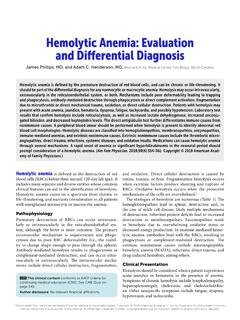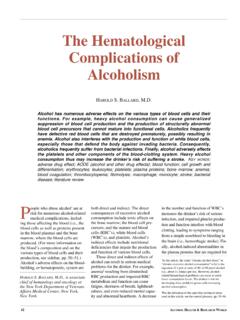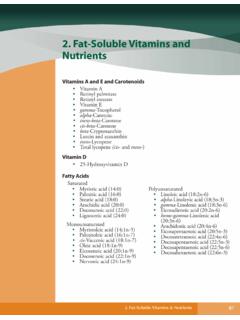Transcription of Hepatitis B: Diagnosis and Treatment
1 April 15, 2010 Volume 81, Number 8 American Family Physician 965 Hepatitis B: Diagnosis and TreatmentTHAD WILKINS, MD; DAVE ZIMMERMAN, MD; and ROBERT R. SCHADE, MD Medical College of Georgia, Augusta, Georgia Globally, an estimated 350 million persons are chronically infected with Hepatitis B virus (HBV), resulting in 600,000 deaths annually from cirrhosis, liver failure, and hepatocellular ,2 Approximately 88 percent of the world s population live in regions where the prevalence of chronic HBV infection among adults is more than 2 The prevalence of HBV infection in the United States is percent, with an esti-mated to million persons chronically ,4 With the implementation of vacci-nation programs in 1991, the incidence of new infections in the United States has declined from cases per 100,000 persons in 1985 to cases per 100,000 persons in ,4 Virus DescriptionHBV is a small (diameter of 42 nm), incom-pletely double-stranded DNA hepadnavi-rus.
2 Substantial genetic variations occur within distinct regions, globally facilitating classification of eight distinguishable geno-types (A through H), which have Treatment All genotypes are present in the United States, with genotypes A and C comprising 35 and 31 percent of viruses, The HBV genome produces a nucleocapsid that contains the Hepatitis B core antigen (HBcAg). This nucleocapsid is encompassed with an outer envelope referred to as the Hepatitis B surface antigen (HBsAg). One segment of HBcAg results in the pro-duction of the Hepatitis B e antigen (HBeAg), which is associated with viral replication and high infectivity. The DNA polymerase reverse transcriptase is a target for antiviral HBV is transmitted in blood and secretions ( , semen, saliva) and is infectious outside the body for seven or more and PreventionHigh-risk populations should be screened for HBV infection6 (Table 13).
3 The Centers for Disease Control and Prevention recom-mends routine HBV screening in popula-tions in which HBsAg prevalence is at least 2 percent, including immigrants from these Although an estimated 1 million persons in the United States are chronically infected with Hepatitis B virus, the prevalence of Hepatitis B has declined since the implementation of a national vaccination program. Hepatitis B virus is transmitted in blood and secretions. Acute infection may cause nonspecific symptoms, such as fatigue, poor appetite, nausea, vomiting, abdominal pain, low-grade fever, jaundice, and dark urine; and clinical signs, such as hepatomeg-aly and splenomegaly. Fewer than 5 percent of adults acutely infected with Hepatitis B virus progress to chronic infection. The Diagnosis of Hepatitis B virus infection requires the evaluation of the patient s blood for Hepatitis B surface antigen, Hepatitis B surface antibody, and Hepatitis B core antibody.
4 The goals of Treatment for chronic Hepatitis B virus infection are to reduce inflammation of the liver and to prevent complications by suppressing viral replication. Treatment options include pegylated interferon alfa-2a administered subcutane-ously or oral antiviral agents (nucleotide reverse transcriptase inhibi-tors). Persons with chronic Hepatitis B virus infection should be monitored for disease activity with liver enzyme tests and Hepatitis B virus DNA levels; considered for liver biopsy; and entered into a sur-veillance program for hepatocellular carcinoma. (Am Fam Physician. 2010;81(8):965-972. Copyright 2010 American Academy of Family Physicians.) Patient information: A handout on Hepatitis B is available at http://family This clinical content con-forms to AAFP criteria for evidence-based continuing medical education (EB CME)ILLUSTRATION BY JOHN KARAPELOUH epatitis B966 American Family Physician Volume 81, Number 8 April 15, 2010 Hepatitis B vaccine is part of routine immunizations in the United States, and as a result, the incidence of HBV has Table 2 lists Hepatitis B vaccines and recom-mended dosing A Cochrane review confirmed that Hepatitis B vacci-nation decreased HBV infection in health care professionals (relative risk = ; 95% confidence interval, to ).
5 12 Because there is a high risk of acquiring HBV from a needlestick injury,13 health care profession-als exposed to HBsAg-positive blood should be given Hepatitis B immune globulin after the exposure and started on the Hepatitis B vaccine series if not previously Hepatitis B vaccination and Hepatitis B immune globulin are also effective in pre-venting HBV infection in newborns of mothers infected with Populations to consider for Hepatitis B vaccination are listed in Table Diagnosis The Diagnosis of HBV infection requires the evaluation of the patient s blood for HBsAg, Hepatitis B surface antibody (HBsAb), and Hepatitis B core antibody (HBcAb). Although the presence of HBsAg indicates that the person is infectious, the presence of HBsAb indicates recovery and immunity from HBV infection or successful immuni-zation against HBV. HBcAb appears at the onset of acute HBV infection, but may also indicate chronic HBV infection.
6 Interpreta-tion of HBV immunologic markers is shown in Table HBV DNA sometimes may be the only marker present in early infections. ACUTE INFECTIONS ymptoms of acute HBV infection are non-specific and include fatigue, poor appe-tite, nausea, vomiting, abdominal pain, low-grade fever, jaundice, and dark urine. Clinical signs include liver tenderness, hepa-tomegaly, and splenomegaly. Acute HBV infection typically lasts two to four months. Approximately 30 to 50 percent of children five years and older and most adults are symptomatic; infants, children younger than five years, and immunosuppressed adults are more likely to be In adults Table 1. Populations Recommended for HBV ScreeningDonors of blood, plasma, organs, tissue, or semen*Health care professionalsHousehold contacts of persons with HBV infectionInfants born to mothers identified as HBsAg positive Injection drug users*Men who have sex with men*Persons born in countries with HBsAg prevalence of 2 percentPersons born in the United States who were not vaccinated as infants and whose parents were born in regions with HBsAg prevalence of 8 percentPersons infected with human immunodeficiency virusPersons needing immunosuppressive therapy (chemotherapy and immunosuppression for rheumatologic or gastrointestinal diseases)*Persons undergoing hemodialysis*Persons with persistently elevated aspartate and alanine transaminase levelsPregnant womenSex partners of persons with HBV infectionSurvivors of sexual assaultHBsAg = Hepatitis B surface antigen; HBV = Hepatitis B virus.
7 * New recommendations from the Centers for Disease Control and from reference : KEY RECOMMENDATIONS FOR PRACTICEC linical recommendationEvidence ratingReferencesHigh-risk populations should be screened for HBV care professionals should receive Hepatitis B B vaccination and Hepatitis B immune globulin are effective at preventing HBV infection in newborns of mothers infected with persons who meet criteria for chronic HBV infection should be evaluated for with chronic HBV infection who are not immune to Hepatitis A should receive two doses of Hepatitis A vaccine at least six months apart. C6 Patients in the active phase of chronic HBV infection should receive in the inactive or immune tolerant phases of chronic HBV infection should be monitored on a regular basis (every six to 12 months) for reactivation of their infection. C6 HBV = Hepatitis B = consistent, good-quality patient-oriented evidence; B = inconsistent or limited-quality patient-oriented evidence; C = consensus, disease-oriented evidence, usual practice, expert opinion, or case series.
8 For information about the SORT evidence rating system, go to BApril 15, 2010 Volume 81, Number 8 American Family Physician 967with healthy immune systems, approximately 95 per-cent of acute infections are self-limited, with patients recovering and developing Fewer than 5 percent of adults acutely infected with HBV progress to chronic infection. A small number (1 percent) develop acute hepatic failure and may die or require emergent liver INFECTIONHBV infection is considered chronic when it persists longer than six months. Risk of chronic HBV infection is inversely related to age, with chronic infection devel-oping in about 90 percent of infected infants, 30 per-cent of children younger than five years, and less than 5 percent in all other Occult HBV infection may be reactivated by chemotherapy or other immu-nosuppressants. Coinfection with human immuno-deficiency virus (HIV) or Hepatitis C virus can occur.
9 All persons who meet criteria for chronic HBV infec-tion should be evaluated for Persons with chronic HBV infection who are not immune to hepati-tis A should receive two doses of Hepatitis A vaccine at least six months Goals of TherapyThe goals for Treatment of chronic HBV infection are to reduce inflammation of the liver; prevent liver failure and cirrhosis; and reduce the risk of hepato-cellular carcinoma by suppressing HBV replication. Table 2. Hepatitis B Vaccines and Recommended Dosing Schedules VaccineDosingChildrenScheduleAdult ScheduleEngerix-B 10 mcg ( vial)Birth; one to two months, and six to 18 months of age20 mcg (1-mL vial)Time of first injection and then at one to two, and four to six monthsRecombivax HB 5 mcg ( vial)10 mcg (1-mL vial)Comvax ( Hepatitis B and Haemophilus influenzae type b)* 5 mcg ( vial)Two, four, and 12 to 15 months of age Pediarix ( Hepatitis B; diphtheria and tetanus toxoids and acellular pertussis; and inactivated polio)* 10 mcg ( vial)Two, four, and six months of age Twinrix ( Hepatitis A and B) 20 mcg (1-mL vial)Time of first injection and then at one, and six to 12 monthsNOTE: Other vaccination regimens can be found at and * Should not be given to infants younger than six weeks.
10 Should not be given to persons older than seven from references 9 through 3. Populations to Consider for Hepatitis B Vaccination Children and adolescents younger than 19 years who have not been vaccinated previouslyHealth care and public safety workers at risk of exposure to blood or blood-contaminated body fluidsInfants, beginning at birthInjection drug usersMen who have sex with menPersons seeking evaluation or Treatment for a sexually transmitted infectionPersons seeking protection from HBV infection (acknowledgment of a specific risk factor is not a requirement for vaccination)Persons with chronic liver disease; end-stage renal disease (including predialysis, peritoneal dialysis, hemodialysis, and home dialysis); or human immunodeficiency virus infectionResidents and staff of facilities for persons who are developmentally disabledSexually active persons who are not in a long-term, mutually monogamous relationship ( , persons with more than one sex partner during the past six months)Susceptible household contacts or sex partners of persons identified as HBsAg positive Travelers to regions with intermediate or high rates of endemic HBV infectionHBsAg = Hepatitis B surface antigen.












